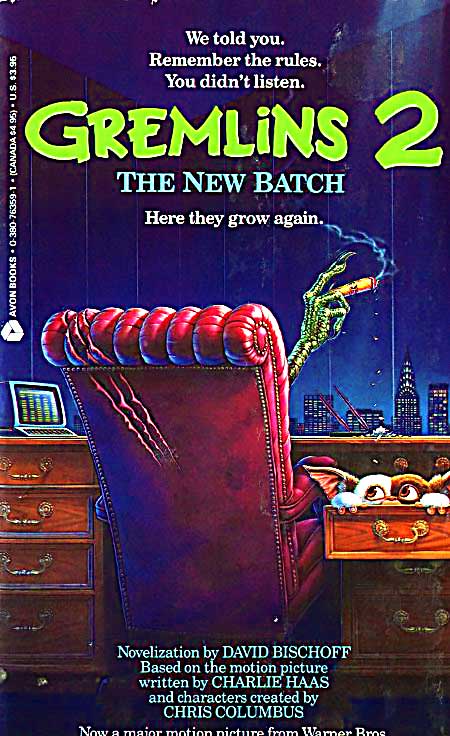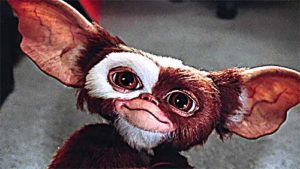 By DAVID BISCHOFF (Avon; 1990)
By DAVID BISCHOFF (Avon; 1990)
GREMLINS 2: THE NEW BATCH is an interesting, if not entirely successful, flick. A cheap, scaled-down sequel to the iconic first film, GREMLINS, it’s a typical Hollyweird product in many respects—which is to say a cynical project whose sole reason for existence was to net its makers a quick buck (STAR WARS, let’s not forget, was at one point set to get the same treatment). Director Joe Dante, however, elected to run wild with his limited resources, creating a goofy free-for-all of a movie whose likes hadn’t been seen in Hollywood since the days of HELLZAPOPPIN (1941). This approach didn’t make for a “good” film by any means but, again, it did make for an interesting one.
A cheap, scaled-down sequel to the iconic first film, GREMLINS, it’s a typical Hollyweird product in many respects…
The novelization by David Bischoff replicates the film’s unfettered spirit with a mountain of self-referential gags (Dante is directly referenced more than once, as a “nice Italian boy”) and an overall atmosphere of uninhibited silliness. Bischoff appears to have been reacting to the constraints placed upon the writing of this book much in the same way Dante did in the making of the film: by going joyously wild.
The novelization by David Bischoff replicates the film’s unfettered spirit with a mountain of self-referential gags…
The story, as you might guess, is pretty dumb, positing that Billy, the hero of the first GREMLINS, works in a New York City high rise controlled by Daniel Clamp, a millionaire blowhard patterned after a certain someone we all know a little too well. Unlikely enough, Billy’s girlfriend Kate (she of the legendary “Why I hate Christmas” speech) also works in the Clamp building, as a tour guide. Another returnee from the first GREMLINS is Gizmo, the cute Mogwai who caused the initial Gremlin outbreak, and who after his master dies finds himself stuck in a genetics lab situated in the Clamp building.
The story, as you might guess, is pretty dumb…
 Gizmo of course ends up birthing a new batch of Mogwai after water is poured on him. Those Mogwai quickly transform into evil Gremlins upon chowing down after midnight (Bischoff takes the opportunity to make fun of those rules in an early passage, in which a character wonders about differing time zones affecting the after midnight decree). Chaos ensues within the Clamp building, bolstered by serums from the genetics lab that wreak various odd changes upon the Gremlins, most notably turning one of them into a bespectacled professorial type identified as “Mr. Glasses.”
Gizmo of course ends up birthing a new batch of Mogwai after water is poured on him. Those Mogwai quickly transform into evil Gremlins upon chowing down after midnight (Bischoff takes the opportunity to make fun of those rules in an early passage, in which a character wonders about differing time zones affecting the after midnight decree). Chaos ensues within the Clamp building, bolstered by serums from the genetics lab that wreak various odd changes upon the Gremlins, most notably turning one of them into a bespectacled professorial type identified as “Mr. Glasses.”
The highlight of the book occurs in chapter nineteen, in which, in place of the fake film break that occurred in the flick (after which Gremlins are seen taking over the movie theater), the author is tied up and Mr. Glasses briefly takes over the story, proclaiming “In the great paradigm of anti-intellectualism that is the vast American untermenchen, there needs to be a seismic quake of thought, a veritable avalanche of anarchy, to wake you somnambulant beings from your couch potato torpor.”
“In the great paradigm of anti-intellectualism that is the vast American untermenchen, there needs to be a seismic quake of thought, a veritable avalanche of anarchy, to wake you somnambulant beings from your couch potato torpor.”
No, this book will never be mistaken for WAR AND PEACE, and neither will the film it novelizes. Both, however, are worth a look for viewers/readers who aren’t averse to some healthy anarchy.
